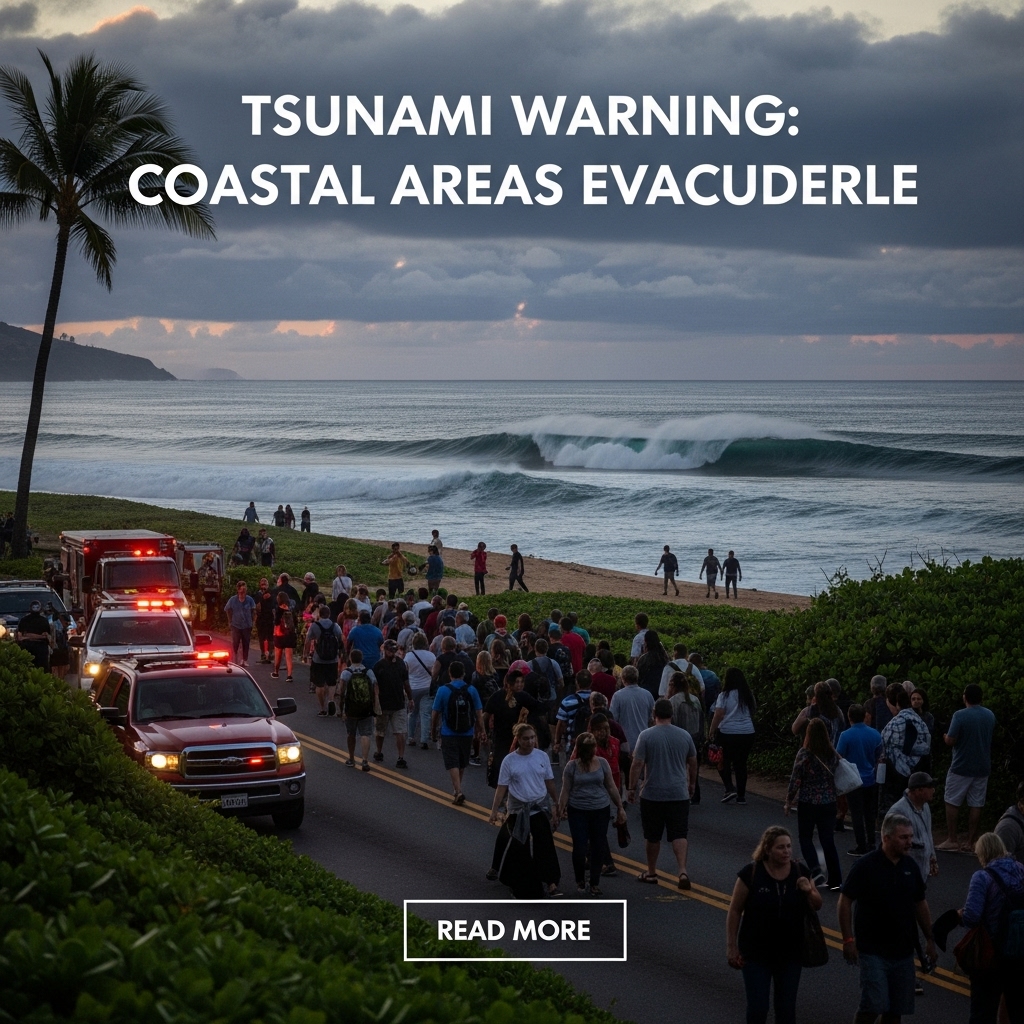Physical Address
304 North Cardinal St.
Dorchester Center, MA 02124
Physical Address
304 North Cardinal St.
Dorchester Center, MA 02124

A massive 8.8-magnitude earthquake that struck off the eastern coast of Russia on Tuesday evening has triggered a tsunami warning across parts of the Pacific, prompting evacuations and emergency alerts in Hawaii and the Northern California coastline. The event marks one of the most powerful seismic disturbances recorded globally in over a century.
The Pacific Tsunami Warning Center issued a full tsunami warning for Hawaii, where the first waves were recorded arriving around 7:17 p.m. local time. In Honolulu, residents faced traffic gridlock as evacuation orders coincided with evening rush hour. Sirens blared across coastal cities including Lahaina and Waikiki as state officials urged people to seek higher ground or shelter in multistory buildings.
Simultaneously, the National Weather Service expanded its tsunami warning for Northern California — covering areas from Cape Mendocino to the Oregon border — urging residents to evacuate low-lying coastal areas and avoid beaches, harbors, and marinas.
The Bay Area, including San Francisco, remains under a tsunami advisory. Although no large-scale evacuations were ordered there, emergency services have asked the public to stay away from the water and prepare for possible strong waves and unpredictable currents.
“Just want to emphasize: the threat is to the water right now,” said Dylan Flynn, a meteorologist at the NWS Bay Area office. “If you’re not on the coast, there’s no need to panic. But coastal zones must remain alert.”
Crescent City, which has a long history of tsunami damage, is facing heightened risk due to its geographical vulnerability. Warning sirens were sounded, and residents in RV parks and beachfront properties were urged to evacuate. Harbor patrols directed around 100 boats to safer waters offshore.
“This won’t be like 1964 where the whole city flooded, but for areas close to sea level, it’s a serious threat,” said Ryan Aylward of the National Weather Service in Eureka.
Farther south, campgrounds in Humboldt and Mendocino counties, including Gold Bluffs Beach and Usal Beach, were also evacuated due to poor cell reception and the potential that campers might not receive digital alerts.
In Hawaii, emergency officials activated sirens and loudspeakers throughout the islands. Popular tourist areas, including Waikiki Beach and the Disney Aulani Resort, were cleared by nightfall. Guests were moved to upper floors, and all commercial flights into and out of airports like Hilo International were suspended.
“Please take this seriously,” said Hawaii Governor Josh Green, who signed an emergency proclamation. “Our emergency centers are activated, and we are prepared for multiple wave surges.”
Charles McCreery, director of the Pacific Tsunami Warning Center, warned that multiple waves could reach heights up to 10 feet, with some growing stronger over time.
In Japan, over 900,000 residents were urged to evacuate from coastal municipalities. While initial tsunami waves in ports like Hanasaki and Tokachi measured under a meter, authorities warned that stronger waves could follow. Meanwhile, Mexican authorities also issued alerts, instructing the public to avoid beaches and coastal waters.
Airlines such as Hawaiian Airlines and Alaska Airlines temporarily halted flights to Hawaii, citing passenger safety and emergency prioritization. Travelers across San Francisco, Los Angeles, and San Diego were advised to check flight statuses due to widespread delays and diversions.
In Monterey County, California, evacuation warnings were issued for boaters living aboard vessels in Moss Landing, and emergency responders stood ready to assist with coastal evacuations if necessary.
According to the U.S. Geological Survey (USGS), the 8.8-magnitude quake ranks as the sixth-largest earthquake globally since 1900. Its epicenter was located east of Petropavlovsk-Kamchatsky, in Russia’s Far East.
Experts emphasized the dangers of underestimating tsunamis: “This isn’t a single surf wave. It’s a massive push of ocean water that can arrive in successive waves over hours,” said NOAA tsunami warning coordinator Dave Snider.
As the situation continues to develop, the National Weather Service and other emergency agencies are urging the public to stay informed via official channels. Tsunami hazard maps are available for California residents to identify potential inundation zones.
Officials warn that waves can persist for up to 24 hours, with aftershocks and smaller surges posing continued risks long after the first wave hits.
“Do not go to the coast to take pictures,” warned meteorologist Brayden Murdock. “You’re not just endangering yourself — you’re risking the lives of first responders.”